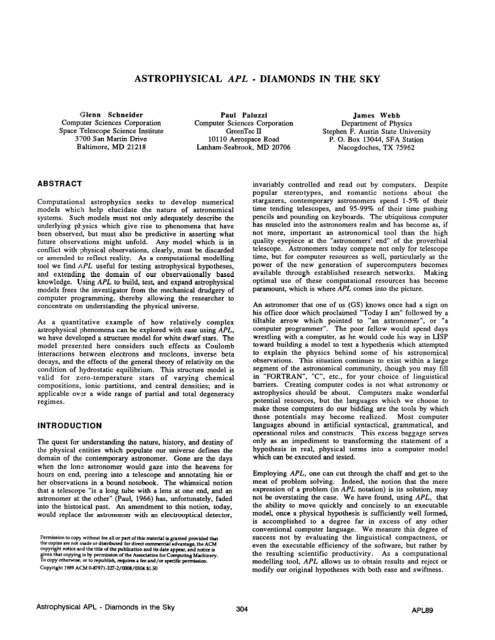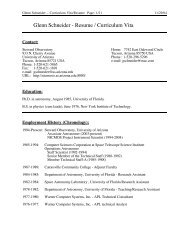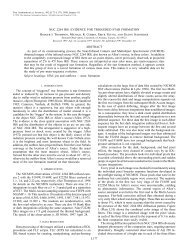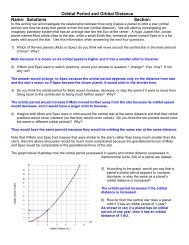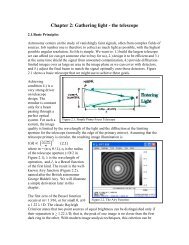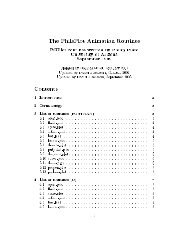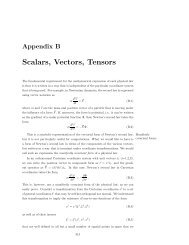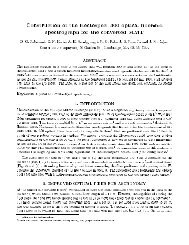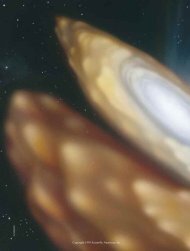ASTROPHYSICAL APL - DIAMONDS IN THE SKY
ASTROPHYSICAL APL - DIAMONDS IN THE SKY
ASTROPHYSICAL APL - DIAMONDS IN THE SKY
Create successful ePaper yourself
Turn your PDF publications into a flip-book with our unique Google optimized e-Paper software.
In this paper we will outline the development of anastrophysical model using <strong>APL</strong>. To illustrate the flexibilityand lucidity of the notation, we attempted to identify thoseconditions which are often stated by <strong>APL</strong> opponents as beingadverse to the creation of an <strong>APL</strong> model, and then fmding anastrophysically interesting situation for which thoseconditions applied. In essence, we looked for things whichwe, and others, have conjectured that <strong>APL</strong> does not handlewell, and forced their incorporation into our model.Specifically, we demanded that the modeling of the physicalprocess under evaluation must be fundamentally iterative innature, forcing branching and re-execution of the linguisticalconstructs to be employed. Additionally, since <strong>APL</strong> naturallyhandles the manipulation of extensive multidimensionalarrays with ease (Metzger, 1981), in an adverse test the data tobe processed were to be of low rank (scalars, vectors, andmatrices) containing, in general, very small numbers ofelements. Since we were testing a numerical model, we feltthat the process should inherently have been computationallyextensive. Finally, for this illustrative example to bemeaningful to a broad spectrum of potential readers, we wishedto find a physical situation which was intrinsicallyinteresting, and not too narrowly channeled. To the latterpoint, the techniques used in the model would have to beroutinely used in diverse astronomical and physicaldisciplines.We felt that the classical problem of developing a stellarstructure model for white dwarf stars fit all of the abovecriteria. The numerical integrations of the structure equationsfrom the center of the star to the surface are inherently iterativeand computationally intensive. Yet, the physical situation isparametrized by only a few variables, and the number ofnumerical elements involved in each iteration step is small. Indeveloping the <strong>APL</strong> model, the method of approach to thesolution is as important as, and indeed is part of, the solutionitself. The actual “code” (a term we use hesitantly) isdeveloped in a bottom-up fashion, following the structuring ofthe physical principles employed in the model. There isnothing unique, ground breaking, or particularly inventive inthe implementation of the model which we present. Theunderlying physics is well understood. Indeed, this was anadditional requirement we imposed upon ourselves in selectinga situation to model for illustrative purposes.STRUCTURE MODELS - GENERAL CONCEPTSFor the purposes of developing a model of a stellar interior,the star may be thought of as being comprised of manyinfintesmally thin, spherically concentric shells. A structuremodel seeks to determine how the physical properties of thestar change at varying depths within the interior. Thisamounts to determining the “run of physical variables” fromthe center of the star to the surface (or vice-versa), througheach of the spherical shells. Some of the physical variableswhich are of interest include pressure and density at varyingdepths (i.e., within each shell), and the mass interior to eachshell.The process of solving the interior model involves expressingthe physical relationships between the structure variables asfunctions of the radial distance from the center of the star, andthen determining the numerical values of each of thosevariables throughout the interior. The form of the classicaldifferential equations of stellar structure, as described bySchwarzschild (1958), are discussed here as a background todeveloping the <strong>APL</strong> model which we will present.In the interior of a star two forces are in constant competition.The inward acting force of gravity, due to the star’s own mass,seeks to pull the outer layers of the star downward. Theinternal pressure of the gas, which comprises the stellarmaterial, acts to check this gravitational collapse. For thevast majority of a star’s life these two forces are in balance andthe star remains stable. This condition of hydrostaticequilibrium is expressed, for a region in the stellar interior, byequation [ 11.dPldr = -Gmrp ,/r* 111The pressure gradient (d Prldr ) across the regionspherical shell) in hydrostatic equilibriumdepends upon:(i.e.,r = the radial distance from the center of the starmr= the total mass interior to the regionpr= the density of the regionThe distribution of mass as a function of the radial distancefrom the center of the star is expressed by the equation of masscontirmity, written in differential form in equation [2]. As canbe seen, the differential equations of hydrostatic equilibriumand mass continuity both require a knowledge of the density ofthe region before they can be integrated.dmjdr = 4m-* p, VIThe gas pressure is related to the temperature and densitythrough an equation of state. The form of the equation of statedepends upon the underlying physics which governs thebehavior of the gas. The “perfect gas law”, which most of uslearned in high school chemistry, comes quite close to realityin physical situations of relatively low gas density, such as inthe Earth’s atmosphere and for most of the interior regions ofmain sequence stars. The perfect gas law assumes that thecollisional statistics between the particles in the gas arestrictly Maxwellian; all collisions are perfectly elastic, andboth external and inter-particle forces (such as Van der Wallsforces) are ignored (Sears, 1952). Under higher gas density, asoccur in the case of white dwarf stars, such simple assumptions’will not suffice.The third equation which describes the structure of the stellarinterior is the luminosity gradient equation, expressed in themost general form in equation [3]. This equation states thatthe radially directed luminosity gradient (i.e., the the netenergy loss), across the region is exactly compensated for bythe energy generated within the region. The energy generatedper unit mass, E, must include all energy sources. For mainsequence stars only nuclear energy sources are important,During the pre-main sequence phases of stellar evolution,when the star is undergoing gravitational contraction, boththermal and gravitational energy must also be considered.dLrldr = Edmjdr [31Equation [4], which has two forms, describes the radialtemperature gradient (d Tr/d r ) across a spherical shell in thestellar interior.<strong>APL</strong> QUOTE QUADSchneider, Paluui and Webb
d Tidr = [-3KLrp/16nacr2 ~,3]~~~ PaId T/dr = [ (1 -Y-l) (frlPJ dq/d rlconv [4blThe appropriate form of equation [4] to use in the.regiondepends upon whether the mode of energy transport is radiativeor convective. To determine this, the convective form of [4]may be cast as an inequality (Chandrasekhar, 1967). If theregion is to be stable against adiabatic convection, then themagnitude of the temperature gradient (d T,/di) must be lessthan the magnitude of adiabatic temperature gradient. Here,K = the opacity of the regiona = the Stephan-Boltzman constantC = the speed of lighty = the ratio of specific heats of the gas(513 for highly ionized gas)As is apparent, the differential equations of stellar structure,[l] - [4], are ~nutually dependent and must be simultaneouslyintegrated to determine the run of the physical variables. Theboundary values for the integrations must come from anunderstanding of the physical properties at the stellar surfaceand/or center.<strong>THE</strong> CASE FOR WHITE DWARF STARSA star spends most of its life creating energy by nuclear fusiondeep in its interior, converting Hydrogen to Helium throughthe “proton-proton” or “C-N-O” cycles. More massive,evolved stars may also fuse heavier elements, such as Heliuminto Carbon via the “triple alpha” process. In either case theenergy generated in the core provides a sufficient radiantenergy flow to support the weight of the outer lying layers, asexpressed by the equation of hydrostatic equilibrium. At somepoint in the life cycle of a star, the available nuclear fuel in thecore will be expended. The condition of hydrostaticequilibrium will be violated and the star will collapse under itsown gravitational force. The final configuration which will bereached at the end of this rapid collapse depends upon the massof the star. In any case the outer envelope of the star will beexpelled (perhaps violently) or eventually depleted. Theremnant stellar core, internally heated and compressed to veryhigh densities by the stellar collapse, is all that will remain ofwhat once was a main sequence star. The compressed corematerial, often nearly pure Carbon for stars of the appropriateinitial mass, is crystalized during the collapse making somewhite dwarfs truly diamonds in the sky.White dwarf stars have peculiar physical properties which insome ways greatly simplifies developing numerical models oftheir interiors, and in other ways complicates mattersenormously. First, simplicity.White dwarfs represent the final stage of evolution for manystars. As nokd, at this phase in a star’s life nuclear energygeneration processes in the interior have terminated, as thefusionable material has been exhausted. Further, the star isonce again in hydrostatic equilibrium, so there is no thermalenergy generation to speak of. Therefore, the luminositygradient, expressed in equation [3] is 0, since E is 0.White dwarf stars are essentially isothermal. Since there is nophysical mechanism for energy generation within the interior,the thermal energy containedthere is a remnant of the corecollapse. This remnant thermal energy is bottled up within thestar since white dwarfs have small surface areas (typically, lessthan 10e6 that of the sun). Additionally, a very thin radiativeregion must exist at the surface. At the interior/surfaceinterface the temperature gradient is large, since the internaltemperatures of newly formed white dwarfs are on the order of afew million degrees, while the surface temperatures areobserved to be a few times lo4 K. Given a small thin radiativesurface area, with a large temperature gradient, white dwarfstars have very long thermal cooling times. Therefore, exceptfor this very thin region at the surface, the temperaturegradient in the interior is essentially zero. For these reasonswhite dwarfs are considered thermally cold, and d Tr ldr inthe interior is 0.Since both the luminosity and thermal gradients (equations [3]and [4]) are zero throughout the interiors of the white dwarfs,the physical characteristics of the interiors of these stars maybe inferred only from the differential equations of hydrostaticequilibrium and mass continuity. Hence, we mustsimultaneously integrate only the first two of the fourdifferential equations of stellar structure.Several complications arise due to the high particle densitieswhich occur in the interiors of white dwarfs. The gas does notbehave in accordance with the “perfect gas law”, and indeed isdegenerate. In a degent,ate gas both the momenta and thepositions of the particles are constrained.The Pauli exclusion principle dictates that no two electronscan have the same position, momentum and spin. TheHeisenberg uncertainty principle states that one cannot, evenin principle, determine the position and momentum of aparticle simultaneously. The location of the particle may bedescribed by its coordinates in a six dimensional phase space;the coordinates being the orthogonal components of theposition and momentum vectors. This phase space,conceptually, is comprised of individual cells (whose sidesrepresent conjugate variable pairs in position and momentum,and whose volume is h 3). As the gas density increases, thephase space cells begin to fill up, with the lowest momentumcells being occupied first. Since each cell can hold only twoelectrons, the distribution function becomes constrained, andis no longer Maxwellian. Such a gas is said to be partiallydegenerate.In this case, the particle number density and pressure can bederived utilizing Fermi-Dirac statistics. The equation of state(for a given atomic species) may then be characterized by asingle parameter representing the energy of the most energeticparticle found in the Fermi-Dirac distribution. This parameter,X, is referred to as the “relativity parameter”, and is related tothe particle momentum by the usual relativistic relation:x = po/mc [51where p. is the particle momentum.The density is related to the relativityequation [ 61.parameter, X, throughp = pMu(xmec/fi)3/37c2 [61Astrophysical <strong>APL</strong> - Diamonds in the Sky 306 <strong>APL</strong>89
where,P = the ratio of atomic mass to nuclear chargeMU = one atomic mass unit (i.e. 1.6604x10-% gm)Cme= the speed of light= the mass of an electronWhen the phase space cells are completely filled the gas is saidto be totally degenerate. At this point no additional particlescan be added to the phase space without violating the Pauliexclusion principle. If the pressure exerted on the totallydegenerate gas were to be increased further, say by theapplication of a stronger gravitational field, inverse P-decaywould set in. In this process, an electron with “no place to go”(in phase space) would be driven into a proton and combine toform a neutron. This combination event is accompanied by atremendous energy release, and, if unchecked in the core of astar, results in the onset of a supernova collapse. As we willsee, this sets a limiting mass, the Chandrasekhar limit, forwhite dwarf stars.In the model we present here we.have chosen the equation ofstate (EOS) of a degenerate gas developed by Salpeter (1961, p.669). This EOS incorporates corrections for Coulombinteractions between nucleons and electrons, and bothcorrelation and exchange energy terms. In addition, this EOSconsiders Thomas-Fermi excess charge distribution effectswhich become important at high densities where the process ofinverse p-decay contributes to the ionic characteristics of thedegenerate gas, as discussed by Hamada and Salpeter (1961. p.683).Another complication arises from the gravitational field of awhite dwarf being so strong that the effects of the generaltheory of relativity (GTR) cannot be ignored. Here, we are nottalking about a further modification of the equation of state,but rather to the structure equations themselves. For the caseof hydrostatic equilibrium, Zeldovich and Novikov (1971)solved the metric for the gravitational field of a sphericallysymmetric star. By integrating the Einstein field equations,the GTR formulation of the hydrostatic equilibrium conditionbecomes:dPrldr =-G(pr+Pic2)(mr+4nPrr3/c2)r2( 1 -2Gmjrc2)The form of the equation of mass continuity, [2], remainsunchanged in the GTR consideration. However, /?7, here is thetotal mass-energy of the interior region. At large radii, wherethe GTR effects are negligible, this reduces to the total stellarmass. We also note that here the radius, f, is that of anequivalent Newtonian sphere, as r, in principle, isunmeasurable under GTR.AN <strong>APL</strong> MODEL FOR WHITE DWARF STARSArmed with an understanding of the basic physics of whitedwarf stars, we can now proceed to develop a numericalstructure model using <strong>APL</strong>.[71The basic structure of the star is determined by the equations ofmass continuity (equation [2]) and hydrostatic equilibriumunder GTR (equation [7]). The <strong>APL</strong> function DES embodiesthese two differential equations of stellar structure, which mustbe simultaneously integrated to determine the nm of physicalvariables throughout the interior of the star.OD+DES P;SCl1 0Relatiuistic Strut ture EquationsC23 x+(PCll+u)*+3 0 Relativity ParameterC31 qcux(‘EOS z’NEWTON np,x,3LP)t3 FI Dens.t41 Dc4xo (ScPC23t2) xq FI Mass ContinuityC51 r+(l+PC43+cxq,+04xPC2 31+.*3 1),+1-2x+/g,c ,PC3 23C61 D+D,-gxPC3l+Ssqxx/rvft HS EquilibriumDES[2] and DES[3] compute the numerical values of therelativity parameter, X, and the paricle density, p (called q inDES), which are described by equations [5] and [6],respecitively. DES[4] is the differential of the equation ofmass continuity. The three relativistic correction factors,embedded in equation [7], are computed as dimensionlessquantities in DES[S] and stored in the vector, r. DES[6]expresses the GTR realization of the equation of hydrostaticequilibrium. Four parameters are passed to ‘DES as a fourelement vector. The elements of this argument, P, are:P[l] = the gas density at the lower boundaryP[2] =P[3] =P[4] =the distance from the center of the star to the lowerboundarythe total stellar maSs interior to the lowerboundarythe gas pressure at the lower boundaryThe numerical evaluation of the mass continuity equationrequires the determination of density of the degenerate gas atthe point of evaluation. This density may be obtained byinverting the Hamada-Salpeter equation of state, described bythe function EOS.OR+X EOS Z;P;AjWjBjE;LjTCl1 Aiamada-Salpeter Equation of StateC21 P+-5.4777336E20 1.50286882E18+.x(2X2 4+31x(X*4 5)+l,E+40XC 31 L+eB+X+EC41 A+( (B+.tS -5~1 13)+.+32 4)+(1,5xLt2)-0.5626+ (B- .t2 -2) x3+4+LC51 W+A-X+3+(1+X+E)x(+8+B-.t3 -5)+ CL+ .x3 -1,5+B,+B+Bt-31-+4+B-Bt-3C61 Tc8.3656909E20 2.6509094El7+.xW,Xt3C71 R+P+(6.0025406E22~(3~‘50X)+XxE0x-3+2xX*2 1 -TEOS determines the degenerate gas pressure as a function of therelativity parameter, X, for an atomic species of mass Z. EOS,however, is not analytically invertable. Therefore, a Newton-Raphson iteration scheme is employed to determine the gasdensity.<strong>APL</strong> QUOTE QUAD 307 Schneider, Paluui and Webb
vD+A NEWTON P;TCl3 nNewton-Raphson InversionC21 A0:T+&‘PC41’ ,AC33 D~PC~I-(T-~~P)XPC~I+(+‘(+/P~~ 4l)‘,Al-TC41 +BxtPC23>IPC41-DC51 + (xPC33+PE31-ll~A0,PC4l+DC61 D+‘*:ttNO0CONVERGENCE: ‘,TPC41-DThe Newton-Raphson inversion is performed by the <strong>APL</strong>function NEWTON. NEWTON is a general routine which maybe used to munerically invert any equation expressed as a dyadic<strong>APL</strong> function. The left argument of NEWTON names the <strong>APL</strong>function to be inverted, and its invarient right argument(which could. be null), in this case ‘EOS z’. The right argumentof NEWTON, P, is a four element vector defined as follows:P[l] = the value of the differential to be applied incomputing numerical derivativesP[2] =the convergence criterion (numerical precision ofthe solution)P[3] = the maximum number of iterations before abortingt’he inversion due to non convergenceP[4] = the value of the functional argument, (x), at thepoint of inversionThe simultaneous integration of the structure equations,expressed in DES, is handled by the <strong>APL</strong> function RUNGKUT.As implied by the name, this is an implementation of a Runge-Kutta integration procedure. The algorithm employed forsimultaneously integrating the two first order differentialequations was described by Scarborough (1966). The leftargument of IRUNGKUT is the size of the integration step. Theright argument of RUNGKUT are the values of the physicalvariables (density, radius, interior mass, and pressure,respectively) at the lower boundary of the region to beintegrated.OF+D RUNGKUT F;Kl;K2;K3;K4;A;r;q;xCl1 RRunge-Kutta IntegrationC21 Ll :A+‘-4?,Ft31 Kl+DxDES AC41 K2cDxDES A+0,0.5xD,KlC51 K3+DxDES A+0,0.5xD,K2C61 K4+DxDES A+B,D,KBC71 A+A+(q-ltA),D,+6+1 2 2 1+.x4 2pKl,K2,K3,K4C81 F+F,Cllr,x,Ac91 +LlxB^.JAvNormally, one is only interested in the final result of theintegration process. However, the values of the physicalvariables determined at each integration step of RUNGKUTdefine the l?yered structure of the star. Therefore, RUNGKUTnot only returns the values of the physical variables at theouter boundary of the integration, but the values at eachintegration step from the lower boundary outward as well. Theouter boundary crossing is recognized when the computed valueof any of the structure variables becomes negative (asdetermined in RUNGKUT[9]). Physically, this representsstepping out of the interior of the star, and exiting through thesurface layer. Because of numerical roundoff error (eg., due tothe expressed degree of precision in the inversion of EOS byNEWTON) the pressure and the density will not necessarilybecome negative at the same integration step. As will be seen,both the pressure and the density fall off asymptotically as thestellar surface is approached, so this numerical “fuzz” has littleeffect on the physical model.In addition to the structure variables, the relativity parameter,X, and the relativistic correction factors, r, computed by DESat each integration step are accumulated in RUNGKUT[8] andpassed in the final result. RUNGKUT returns an eight columnmatrix, each row containing the values of X, r, p, , r, mr ,and P,.The dyadic function WHITEDWARF controls the numericalmodelling process.-R+E WHITEDWARF M;z;np;u;g;c;UCl1 &tructure Model for White Dwarf StarsC21 cc8.98754E20 ~1 Speed of Light SquaredC31 g+6.6732E-8 FI Gravitational ConstantC41 z+l?M fi Species Atomic Masst51 u+973800xMt31 ~1 Partition FunctionC61 np+lBb-6 -5 2 FI Conuergance, 0, riterC71 RBoundary conditions at center of starC81 U+-8?MC21,10,(oMC21~4000+3~((CMC21%)*+3)EOS z)-og+200+3+MC2lt2C93 R+; 8p’J FI Strut ture MatrixElBl&enter to Surface IntegrationCllILl:R+-1 0~R,tllMC41RUNGKUT 1 8&JCl21 U+‘8t,-1 -4tR FI New Boundaries ValuesCl31 +(E’MC4l+MC41+10)~Ll0The right argument, M, is a four element vector whichcompletely parametrizes the model as indicated below.M[l] = z,M121 = pc.atomic species weight in atomic mass unitscentral density in cgs unitsMI31 = PL, ionic partition function (atomic mass/nuclearcharge)M[4] = Ar, initial value of integration step (dr) in cm.WHITEDWARF[2]-[6] establishes the values of physicalconstants used in the model, in cgs units, and sets up theparameters which control the NEWTON inversion routine (thevector np). These, and the value of z, are passed between thefunctions running under WHlTEDWARF as global variables.Before the numerical integration can begin, the boundaryconditions must be established. The structure model isparametrized by pc, so the density at the center is given. Theapproximation can be made that the density at an infinitesimaldistance, 5, from the center is the same as it is at the center.The boundary values for r are computed analytically inWHlTEDWARF[8], as the vector V. In this model we havefixed 5 to a value of 10 cm. The final result of the center-tosurfaceintegration will be passed as the explicit resuh ofWHlTEDWARF. WHlTEDWARF[9] establishes a matrix, R, toaccumulate this result.Astrophysical <strong>APL</strong> - Diamonds in the Sky 308 <strong>APL</strong>89
The Runge-Kutta integration is invoked by WHlTEDWARF[l l]using the established boundary values. On completion,RUNGKUT will pass the results of its integration from thelower boundary to the surface back to WHITEDWARF. Thevalues in the last row of the matrix passed by RUNGKUT aremeaningless, since this corresponds to some small distanceoutside of the stellar interior. Hence, this row is dropped byWHlTEDWARF[ 121. The structure matrix, then, runs from thelower boundary to as close to the surface as the integrationstep, Ar, allows without stepping out of the interior. Thisregion, under the surface, can be taken as a new lowerboundary, and the integration process may be iterated to get toas close to the surface as desired. WHITEDWARF[13] has beenset up to decrease Ar by a factor of 10 when the Runge-Kuttaintegration is repetitively invoked to closely approach thesurface. The left argument of WHITEDWARF, E, specifies theending value of Ar , for terminating the white dwarf model.The <strong>APL</strong> realization of this physical model is short, concise,and easily understood. The question of what represents “goodprogramming style” in <strong>APL</strong> has been discussed almostendlessly in the literature. The argument has been made thatsome <strong>APL</strong>ers tend to “one-1inerize”. combining unrelated anddisjointed thoughts into a single executable line for the sakeof creating artificial brevity of expression. Sadly, this is true.Such practices have been perpetrated by well intentioned, butoften unthinking <strong>APL</strong>ers, in attempts to win over or impressthose unacquainted with <strong>APL</strong> of its notative compactness.This invariably leads to slanderous, but not always undeservedcomments about “those unreadable chicken scratches”, or theinevitable “looks like Greek to me” remarks.At the other extreme is the notion that <strong>APL</strong> statements must bebroken down into short segments to enhance readability (<strong>APL</strong>Quote Quad, 1985). This typically involves the arbitraryinclusion of ultimately vestigial linguistic constructs whichserve only to cloud the thoughts enveloped in the <strong>APL</strong>expression of the problem as discussed by Berry and Pesch(1986). “Enhancing” the readability of the code byincorporating unnecessary assignment statements andadditional name references is akin to paying an author by theword rather than for his or her words. In the development oflarge software systems, it is not uncommon for progress to bemeasured by the number of lines of executable code. Do wereally want this sort of outlandish situation in <strong>APL</strong>?As a tool of thought a computer language should not imposeartificial linguistic or stylistic constraints on the thinker. Thethought processes which are implicitly mapped into the codeshould not be obscured by “enhancement”, either bylengthening or shortening the notative representation of theproblem at hand. We believe that as a case in point the whitedwarf model presented here illustrates this, and the concept that“<strong>APL</strong> possesses certain important characteristics which speeddevelopment and assist thought” (Bemecky, 1986).In developing our <strong>APL</strong> model of white dwarf stars we made noeffort to either “one-linerize”, or to break up logicallyconnected thoughts to, as suggested by some, aid’ in thereadability of the code. On the contrary, just as each functionrepresents a modular piece of the solution, in a hierarchialsense, each function line represents a discrete “chunk” ofthinking.NUMERICALRESULTSAs with any numerical integration scheme, the precision of thesolution depends upon the granularity of the integration step.We have found that WHITEDWARF will return meaningfulresults even with relatively coarse initial integration steps.As an example, Table 1 shows the actual results obtained fromrunning WHITEDWARF with the input parameters indicated.Here, with 100 km (lE7 cm.) initial integration steps, thetotal stellar mass was found to be within 1% of the “true”value, as indicated by center-to-surface runs with integrationsteps 1000 times smaller.The Fist three terms in the table, RCl, RC2, and RC3 are thedimensionless values of the relativistic correction factorsincorporated in the GTR equation of hydrostatic equilibrium(the vector, r, in DES[2]). As anticipated, all three converge tounity as the surface of the star is approached. Similarly, therelativity parameter, X, approaches zero near the surface whereonly mild partial degeneracy exists. An examination of theincrementing radius indicates that the surface boundary wasfirst crossed between 1.1~10~ and 1.2~10~ cm.WHITEDWARF[3] then reduced the size of the integration stepby a factor of 10 (to lo6 cm.) and re-entered the Runge-Kuttaintegration from the subsurface region. The surface boundarywas again crossed between 1.30x10* and 1.31~10~ cm.WHITEDWARF then terminated since the last value of Ar wasthe same as the terminal value specified by the left argument.Table 1.Sample Run: 1 E6 WHITEDWARF 12 1 El0 2 1 E7EcLIGLluzLxormPO.OOEOO O.OOEOl O.OOEOl 0.00 l.OElO l.OOEl 4.19E13 1.04E261.00101 1.00274 1.00047 17.25 6.77E9 l.OOE7 3SlE31 6.71E271.00097 1.00223 1.00194 15.15 5.97E9 2.00E7 2.54E32 6.04E271.00066 1 .00174 1.00346 14.53 4.16E9 3.00E7 6.79E32 3.44E271.00072 1 .00116 1.00456 12.69 2.50E9 4.00E7 1.20E33 1.69E271.00059 1.00073 1.00514 10.67 1.36E9 5.00E7 1.66E33 7.57E261.00047 1.00042 1.00525 6.67 6.95E6 6.00E7 2.07E33 3.17E261.00036 1.00022 1.00506 7.09 3.42E6 7.00E7 2.35E33 1.26E261.00026 1 .OOOl 1 1.00477 5.60 1.61 E6 6.OOE7 2.53E33 4.76E251.00021 1.00005 1.00442 4.36 7.11 E7 9.00E7 2.65E33 1.67E251 .00014 1.00002 1.00406 3.32 2.74E7 l.OOE6 2.71E33 5.23E241.00006 1 .ooooo 1.00373 2.42 6.65E6 l.lOE6 2.74E33 1.37E24O.OOEOO O.OOEOl O.OOEOO 0.00 6.65E6 l.lOE8 2.74E33 1.37E241.00010 1.00001 1.00368 1.51 1.27E7 l.llE6 2.74E33 1.17E241 .OOOl 0 1 .OOOO 1 1.00365 1 .a7 1.13E7 1.12E6 2.74E33 9.67E231.00009 1 .OOOOl 1.00362 1.60 l.OlE7 1.13E6 2.75E33 6.32E231.00009 1.00001 1.00359 1.73 8.92E6 1.14E6 2.75E33 6.96E231.00006 1 .OOOOO 1.00356 1.66 7.66E6 1.15E6 2.75E33 5.76E231.00006 1.00000 1.00353 1.59 6.69E6 1.16E6 2.75E33 4.76E231.00007 1 .ooooo 1.00350 1.52 6.00E6 1.17E6 2.75E33 3.69E231.00007 1 .ooooo 1.00346 1.46 5.20E6 1.16E6 2.75E33 3.14E231.00006 1 .OOOOO 1.00345 1.39 4.47E6 1.19EB 2.75E33 2.51 E231.00006 1 .OOOOO 1.00342 1.32 3.61 E6 1.20E6 2.75E33 1.97E231.00005 1 .OOOOO 1.00339 1.25 3.22E6 1.21E8 2.75E33 1.53E231.00005 1 .ooooo 1.00337 1.16 2.68E6 1.22E8 2.76E33 1.16E231.00004 1 .ooooo 1.00334 1.11 2.20E6 1.23E6 2.76E33 6.59E221.00004 1 .ooooo 1.00331 1.04 1.78E6 1.24E6 2.76E33 6.16E221.00003 1 .OOOOO 1.003?9 0.97 1.41 E6 1.25E6 2.76E33 4.29E221.00003 1 .OOOOO 1.00326 0.90 1.08E6 1.26E6 2.76E33 2.63E221.00002 1 .OOOOO 1.00323 0.62 7.94E5 1.27E6 2.76E33 1.75E221.00002 1 .OOOOO 1.00321 0.74 5.53E5 1.26E6 2.76E33 9.66E211.00001 1.00000 1.00318 0.66 3.50E.5 1.29E6 2.76E33 4.61 E211 .OOOOl 1 .OOOOO 1.00316 0.56 1.85E5 1.30E6 2.76E33 1.61 E211.00000 1.00000 1.00314 0.46 4.56E4 1.31 E6 2.76E33 4.08E20<strong>APL</strong> QUOTE QUAD 309Schneider, Paluzzi and Webb
By comparing models of white dwarfs of given compositions,one can try to predict how the interior structure and globalproperties of these stars vary as a function of the principlecharacterizing parameter - the central density, pc. The finalresults obtained for the integrated global structure of elevenCarbon white dwarfs (Z=lZ, l.t=2.00) of increasing centraldensity are summarized in Table 2. This table gives the centraldensity (pc)., total stellar mass (M) and radius (R) of each of thestars modeled. The first four columns are in cgs units, whilethe last two columns compare the computed masses and radii ofthe Carbon white dwarfs to that of the sun (Ma and R 0,respectively). Some rather interesting physical properties ofthese stars are predicted by these results.Table 2.Globall Properties of Carbon White Dwarfslog P, 4 Mx~O-~~ Rx~O-~ M/Ma 1 OOFVb_______ __~.---____ ------------ ---------- ---------- ------------7.0 8.:21E23 1.540 6.840 0.774 0.9837.3 2.:22E24 1.785 5.965 0.897 0.8578 .O 2. LOE25 2.253 4.223 1.132 0.6078.3 5.39E25 2.397 3.602 1.204 0.5189 .O 4:?5E26 2.613 2.421 1.313 0.3489.3 l.:20E27 2.665 2.022 1.339 0.29010.0 1.04E28 2.727 1.294 1.370 0.18610.3 2LiOE28 2.736 1.059 1.375 0.15211 .O 2.:24E29 2.733 0.652 1.374 0.09411.3 5.152E29 2.723 0.526 1.369 0.07612.0 482E30 2.682 0.315 1.348 0.045First, as can be seen, white dwarfs with higher central densities(and correspondingly higher central pressures) contain moremass up to a limit of log pc = 10.3. An increase in total masswith increasing central density seems almost obvious fromphysical arguments invoking mass continuity and hydrostaticequilibrium. What is interesting, however, is that the massdoes not increase without bound as a function of pc, butapproaches a maximum 2.74~10~~ grams and then begins todecrease. This critical mass, well known as the Chandrasekharlimit, represents the most massive configuration that a whitedwarf can obtain before mechanical equilibrium begins tobreak down and inverse beta decay sets in. In this conditionthe gas throughout is completely degenerate. If additionalmass were suddenly dumped onto the star, the white dwarf couldimplode forming a neutron star. Chandrasekhar originallypredicted the limiting mass for a white dwarf to be 1.44 solarmasses. This model predicts 1.38 solar masses as an upperlimit. The difference arises when one considers both theeffects of general relativity on the condition of hydrostaticequilibrium and the additional gas pressure terms accounted forin the Hamada-Salpeter equation of state..Second, the radii of white dwarfs decrease with increasingcentral prelrsure, and correspondingly increasing centraldensity. As illustrated in Figure 1, up to the turnover point oflog p, = 10.3, white dwarfs of greater total mass becomephysically smaller! This obviously implies increase in thegas density (and pressure) throughout the interior.Theoretically, as the central density is increased, and asChandraseklnar’s limit is approached, the radius of the stardrops to zero. Clearly, a condition of instability resulting in aphysical change in the overall configuration of the star wouldoccur before such a singularity is reached. Indeed, this isprecisely the condition which would ultimately lead to thecatastrophic formation of a neutron star.I8.7--’ .A--e.s--.A--e.3--.A?--8,1-- logpc lndlc~tdhrcuhcomputed potnte.e, 1 : 1 :8.75 e Al5 8.95 I .es 1.15 1.25 1.35n/n,Figure 1. Mass/Radius Relation for CarbonWhite DwarfsThe interior structure of the star, as a function of the distancefrom the star’s center, may also be inferred from theWHITEDWARF model. For example, Figure 2 shows how thepressure in the interior drops off, from the center of the star tothe surface, for Carbon white dwarfs of varying centraldensities. Both the pressure at a given radius and the radialdistance from the center are normalized to the central pressureand radius at the surface, respectively. This allows for easilyintercomparing the differences in structure, while recognizingthat the actual dimensions of the physical variables changefrom star to star as reported in Table 2. As is apparent, thepressure gradient is more severe close to the center of thosewhite dwarfs with greater central gas pressures (andcorrespondingly greater gas densities).-ll .e e.1 l .2 l .3 e-4 8.5 e.6 l .7 e.e ‘ .eFRACTIONAL RADIUS (r/R,)Figure 2. Pressure Gradient in Carbon WhiteDwarfsThe distribution of mass in Carbon white dwarfs, as predictedin the WHITEDWARF model, is represented in a similarfashion in Figure 3. Here, the fractional mass, m,, is thefraction of the stars mass contained within the correspondingfractional radius. As is obvious from this figure white dwarfstars with higher central pressures are more centrallycondensed.Astrophysical <strong>APL</strong> - Diamonds in the Sky<strong>APL</strong>89
-. -. ---...<strong>APL</strong>.68000~ (1986a,b) distributed by the SpencerOrginization. For those readers who have stayed with us to thebitter end we offer the follwing note of explanation:This paper was not about statement delimitation0in <strong>APL</strong>.’‘We hope the title was not deceiving.’REFERENCES3.3 0.1 3.3 6.3 6.4 3.5 6.6 3.7 6.3 3.6 1.3FRACTIONAL RADIUS (r/R.)Figure 3. Mass Distribution in Carbon WhiteDwarfsIt is beyond the intended scope of this paper to consider thephysical results in greater detail than we have discussed here.For example, we have elaborated on the interrelation of only afew of the structure parameters. Indeed, our principle intentwas to demonstrate the utility of <strong>APL</strong> for moving rapidly andeasily from the physical conception of a given problem to theactualization of a computational model. In particular, while wehave only discussed the WHITEDWARF results for pure Carbonwhite dwarfs, the model inherently will work with other atomicspecies and ionic partitions. We invite the reader to use themodel to build white dwarf stars of his or her l&in (we offer assuggestions for individual exploration He4, Mg 9 4, Si2*. S32,and Fes6).WHITEDWARF serves as a useful tool in its own right inhelping to come to an understanding of the structure of whitedwarf stars. Yet, WHITEDWARF though rigorous in manyways is idealized in others. The model presented here does notconsider such effects as stellar rotation, magnetic fields, massaccretion (in binary systems), and other complicating factorswhich one can posit. For example, in rotating stars one mustconsider how the angular momentum of the gas particlescontributes to the physical stability of the system (Tassoul.1978). Since the angular velocity at a given radial distancefrom the center varies as the cosine of the latitudinal anglemeasured from the rotational equator, the problem becomes atwo dimensional one. Simple spherical symmetry cannot, apriori, be assumed. Moving from a one dimensional model toa two dimensional one in <strong>APL</strong> is almost trivial; for as is wellknown, and accepted even by <strong>APL</strong> opponents, <strong>APL</strong> shines asan array processing language. We leave this for any interestedparties “as an exercise for the reader”.ACKNOWLEDGEMENTS AND F<strong>IN</strong>AL COMMENTSWe would like to thank Dr. Robert Wilson of the University ofFlorida’s Department of Astronomy for first suggesting thisproblem to us. Our gratitude is extended to AndrewWeisenberger of the Space Astronomy Laboratory who wasinstrumental in the initial formulation of this problem. Thismodel was first implemented on a Commodore SP9000(SuperPETTM) computer running Waterloo micro<strong>APL</strong> 1.0(Wilson and Wilkinson, 1981). illustrating that real sciencecan indeed be done in a 28K workspace. The version of theWHITEDWARF code shown here, and the numerical results,were run on a Macintosh@ SE under Micro<strong>APL</strong> Ltd’s<strong>APL</strong> Quote Quad, <strong>APL</strong> Quote Quad Style Guide for <strong>APL</strong>Functions. <strong>APL</strong> Quote Quad 15 3, 1985.Berry, Michael and Pesch, Roland, Style and Literacy in <strong>APL</strong>.<strong>APL</strong>86 Conference Proceedings (<strong>APL</strong> Quote Quad 16 4). 1986.Bemecky. Robert, <strong>APL</strong>: A Prototyping Language. <strong>APL</strong>86Conference Proceedings (<strong>APL</strong> Quote Quad 16 4), 1986.Chandrasekar, S., An Introduction to the Study of StellarStructure. Dover Publications, 1967.Hamada T. and Salpeter E.E., Models for Zero-TemperatureStars. Astrophysical Journal, 134 3, 1961.Metzger, Robert C., <strong>APL</strong> Thinking Finding Array-OrientedSolutions. <strong>APL</strong>81 Conference Proceedings (<strong>APL</strong> Quote Quad12 1). 1981.Micro<strong>APL</strong>, Ltd., <strong>APL</strong>.68000m Language ManuaL.1986.Micro<strong>APL</strong>, Ltd., <strong>APL</strong>.68000” for the AppleTM MacintoshTM.1986.Paul, Henry E., Telescopes for Skygazing. Sky PublishingCorporation, 1966.Salpeter, E.E., Energy and Pressure of a Zero-TemperaturePlasma. Astrophysical Journal, 134 3, 1961.Scarborough, James B., Numerical Mathematical Analysis.sixth edition, The Johns Hopkins Press, 1966.Schwarzschild, Martin, Structure and Evolution of the Stars.Dover Publications, 1958.Sears, Francis, W, Thermodynamics, The Kinetic Theory ofGases, and Statistical Mechanics. second edition, Addison-Wesley Publishing Company, Inc., 1952.Tassoul, Jean L., Theory of Rotating Stars. PrincetonUniversity Press, 1978.Wilson, J.C., and Wilkinson, T.A., Waterloo micro<strong>APL</strong>Tutorial and Reference Manual. 198 1.Zeldovich Ya. B., and and Novikov. I.D., RelativisticAstrophysics. Volume 1, University of Chicago Press, 1971.<strong>APL</strong> QUOTE QUAD 311Schneider, Paluui and Webb. .


